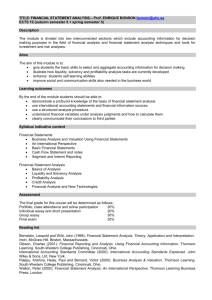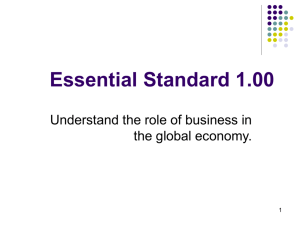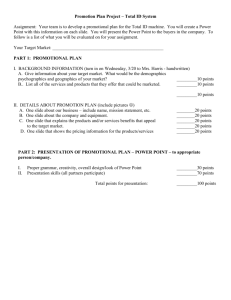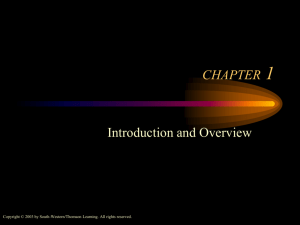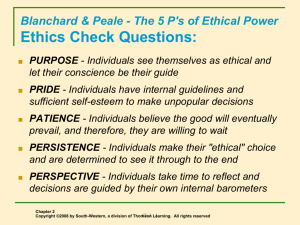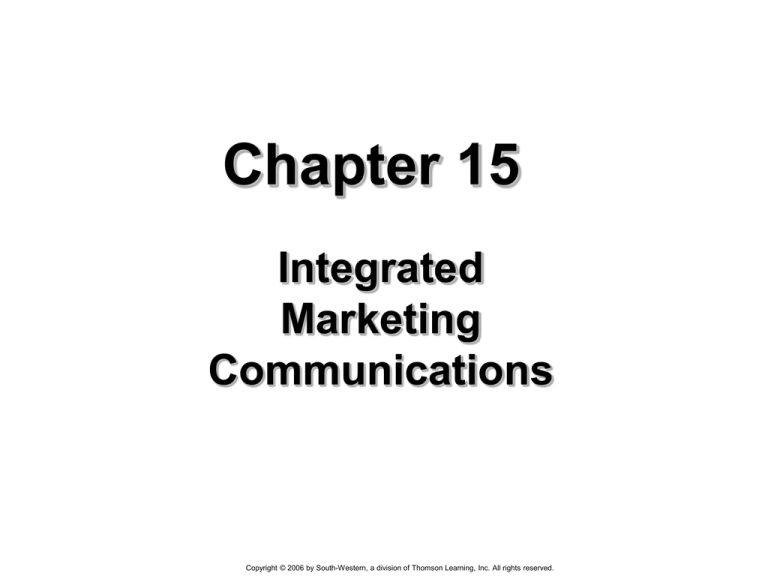
Chapter 15
Integrated
Marketing
Communications
Copyright © 2006 by South-Western, a division of Thomson Learning, Inc. All rights reserved.
Chapter Objectives
1. Explain how integrated marketing communications
relates to the development of an optimal promotional
mix.
2. Describe the communication process and how it relates
to the AIDA concept.
3. Explain how the promotional mix relates to the
objectives of promotion.
4. Identify the different elements of the promotional mix
and explain how marketers develop an optimal
promotional mix.
5. Describe the role of sponsorships and direct marketing
in integrated marketing communications.
6. Contrast the two major alternative promotional
strategies.
7. Explain how marketers budget for and measure the
effectiveness of promotion.
8. Discuss the value of marketing communications.
Copyright © 2006 by South-Western, a division of Thomson Learning, Inc. All rights reserved.
15-2
Promotion
Function of informing, persuading, and
influencing the consumer’s purchase
decision
Marketing Communications
Transmission from a sender to a
receiver of a message dealing with the
buyer-seller relationship
Copyright © 2006 by South-Western, a division of Thomson Learning, Inc. All rights reserved.
15-3
Integrated Marketing Communications
Coordination of all promotional activities –
media advertising, direct mail, personal
selling, sales promotion, and public
relations – to produce a unified customerfocused promotional message
Importance of Teamwork
IMC requires a total strategy including
all marketing activities, not just
promotion
Copyright © 2006 by South-Western, a division of Thomson Learning, Inc. All rights reserved.
15-4
Role of Databases in Effective IMC
Programs
With the growth of the Internet,
marketers have been given the power
to gather information faster and to
organize it easier than ever before
By sharing this knowledge
appropriately among all relative
parties, a firm can lay the foundation
for a successful IMC program
Copyright © 2006 by South-Western, a division of Thomson Learning, Inc. All rights reserved.
15-5
The Communications Process
An effective promotional message
accomplishes three tasks:
It gains the receiver’s attention
It achieves understanding by both
receiver and sender
It stimulates the receiver’s needs and
suggests an appropriate method of
satisfying them
Copyright © 2006 by South-Western, a division of Thomson Learning, Inc. All rights reserved.
15-6
AIDA concept (Attention-InterestDesire-Action) – an explanation of the
steps through which an individual
reaches a purchase decision
Sender
Encoding
Channel
Decoding
Response
Feedback
Noise
Copyright © 2006 by South-Western, a division of Thomson Learning, Inc. All rights reserved.
15-7
Global Difficulties with the Communication
Process
In China: KFC’s slogan: “Finger lickin’ good” came
out as “Eat your fingers off”
Also in China: Coca-Cola had thousands of signs
made using the translation: “Ke-kou-ke-la”
Depending on the dialect this means . . .
“Bite the wax tadpole,” or
“Female horse stuffed with wax”
In Taiwan: Pepsi’s slogan, “Come alive with the
Pepsi generation” came out as “Pepsi will bring
your ancestors back from the dead”
Copyright © 2006 by South-Western, a division of Thomson Learning, Inc. All rights reserved.
15-8
Objectives of Promotion
Provide Information
Increase Demand
Differentiate the Product
Accentuate the Product’s Value
Stabilize Sales
Copyright © 2006 by South-Western, a division of Thomson Learning, Inc. All rights reserved.
15-9
Elements of the Promotional Mix
Promotional mix: blend of personal selling
and nonpersonal selling designed to achieve
promotional objectives
Personal selling: interpersonal
promotional process involving a seller’s
person-to-person presentation to a
prospective buyer
Nonpersonal selling includes:
Advertising, Product placement, Sales
promotion, Direct marketing, Public
relations
Copyright © 2006 by South-Western, a division of Thomson Learning, Inc. All rights reserved.
15-10
Advertising
Paid, nonpersonal communication through
various media by a business firm, not-forprofit organization, or individual identified
in the message with the hope of informing
or persuading members of a particular
audience
Product Placement
Marketer pays a motion picture or
television program owner a fee to display
his or her product prominently in the film
or show
Copyright © 2006 by South-Western, a division of Thomson Learning, Inc. All rights reserved.
15-11
Sales Promotion
Marketing activities that stimulates
consumer purchasing (includes: displays,
trade shows, coupons, premiums,
contests, product demonstrations, and
various nonrecurrent selling efforts)
Trade promotion
Direct Marketing
Direct communications other than
personal sales contact between buyer
and seller, designed to generate sales,
information requests, or store visits
Copyright © 2006 by South-Western, a division of Thomson Learning, Inc. All rights reserved.
15-12
Public relations: firm’s communications
and relationships with its various publics
Publicity: stimulation of demand for good,
service, place, idea, person, or organization
by unpaid placement of commercially
significant news or favorable media
presentations
Guerilla Marketing: Unconventional,
innovative, and low-cost marketing
techniques designed to get consumers’
attention in unusual ways.
Copyright © 2006 by South-Western, a division of Thomson Learning, Inc. All rights reserved.
15-13
Sponsorships
Provision of funds for a sporting or cultural
event in exchange for a direct association with
the events or activity
Growth of Sponsorships
How Sponsorship Differs from Advertising
Sponsor’s degree of control, Nature of the
message, Audience reaction
Ambush marketing
Assessing Sponsorship Results
Copyright © 2006 by South-Western, a division of Thomson Learning, Inc. All rights reserved.
15-14
Direct Marketing Communication Channels
Telephone
Direct Mail
Television
Newspaper
Magazine
Radio
Copyright © 2006 by South-Western, a division of Thomson Learning, Inc. All rights reserved.
15-15
Direct Mail
Marketers combine information from
internal and external databases, surveys,
coupons, and rebates that require
responses to provide information about
consumer lifestyles, buying habits, and
wants
Catalogs
Over 10,000 different consumer mail-order
catalogs and thousands more for
business-to- business sales are mailed
each year generating over $57 million in
consumer sales and $36 million in B2B
sales
Copyright © 2006 by South-Western, a division of Thomson Learning, Inc. All rights reserved.
15-16
Telemarketing: promotional presentation
involving the use of the telephone for
outbound contacts by salespeople or
inbound contacts initiated by customers who
want to obtain information and place orders
Direct Marketing via Broadcast Channels
Broadcast direct marketing includes:
Brief (30 to 90 and second) direct
response ads on television or radio
Home shopping channels like:
Quality Value Channel (QVC)
Home Shopping Network (HSN)
Infomercial
Copyright © 2006 by South-Western, a division of Thomson Learning, Inc. All rights reserved.
15-17
Electronic Direct Marketing Channels
Web advertising is an important component
of electronic direct marketing
E-mail direct marketing is a natural and
easy extension of traditional direct mail
marketing
Other Direct Marketing Channels
Print media is generally not as effective as
Web marketing or telemarketing for direct
marketers
Magazine and newspaper ads with toll-free
telephone numbers, kiosks, and other
media are still useful in many situations
Copyright © 2006 by South-Western, a division of Thomson Learning, Inc. All rights reserved.
15-18
Developing an Optimal Promotional Mix
Factors that influence the effectiveness of
a promotional to mix:
Nature of the market
Nature of the product
Stage in the product life-cycle
Price
Funds available for promotion
Copyright © 2006 by South-Western, a division of Thomson Learning, Inc. All rights reserved.
15-19
Pulling and Pushing
Promotional Strategies
Pulling strategy: promotional effort by a
seller to stimulate demand among final users,
who will then exert pressure on the
distribution channel to carry the good or
service, pulling it though the marketing
channel
Pushing strategy: promotional effort by a
seller to members of the marketing channel
intended to stimulate personal selling of the
good or service, thereby pushing it through
the marketing channel
Copyright © 2006 by South-Western, a division of Thomson Learning, Inc. All rights reserved.
15-20
Budgeting for Promotional Strategy
Percentage-of-sales method
Fixed-sum-per-unit method
Meeting competition method
Task-objective method
Copyright © 2006 by South-Western, a division of Thomson Learning, Inc. All rights reserved.
15-21
Measuring the Effectiveness of Promotion
Two basic measurement tools:
Direct sales results measures the
effectiveness of promotion by revealing
the specific impact on sales revenues
for each dollar of promotional spending
Indirect evaluation concentrates on
quantifiable indicators of effectiveness
like:
Recall
Readership
Copyright © 2006 by South-Western, a division of Thomson Learning, Inc. All rights reserved.
15-22
Measuring Online Promotions
Early attempts at measuring online
promotional efforts involved counting hits
and visits
Incorporating direct response and
comparing different promotions for
effectiveness
Two major techniques for setting online
advertising rates:
Cost per impression (CPM)
Cost per response (click-throughs)
Copyright © 2006 by South-Western, a division of Thomson Learning, Inc. All rights reserved.
15-23
The Value of Marketing Communications
Social Importance
Criticisms of promotional messages as
tasteless and lacking any contribution to
society sometimes ignore the fact that society
provides no commonly accepted set of
standards
The one generally accepted standard in a
market society is freedom of choice for the
consumer
Promotion has become an important factor in
campaigns aimed at achieving socially
oriented objectives like the elimination of drug
abuse
Copyright © 2006 by South-Western, a division of Thomson Learning, Inc. All rights reserved.
15-24
Business Importance
Promotional strategy has become
increasingly important to both small and
large firms
Both business and nonbusiness
enterprises recognize the importance of
promotional efforts
Economic Importance
Effective promotion has allowed society to
derive benefits not otherwise available
Subsidizes the information contents of
newspapers and the broadcast media
Copyright © 2006 by South-Western, a division of Thomson Learning, Inc. All rights reserved.
15-25

